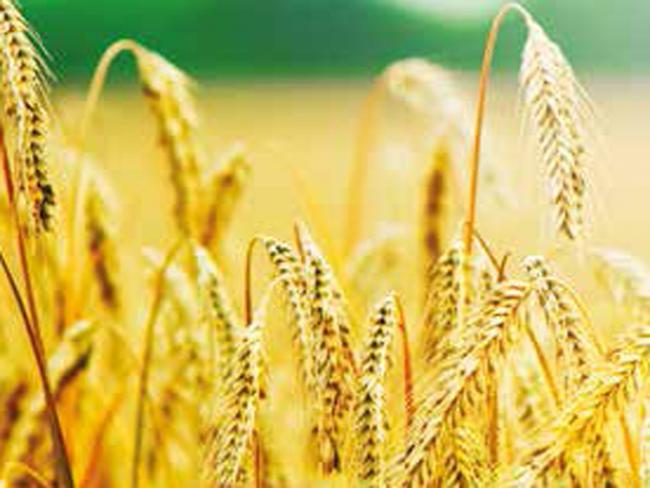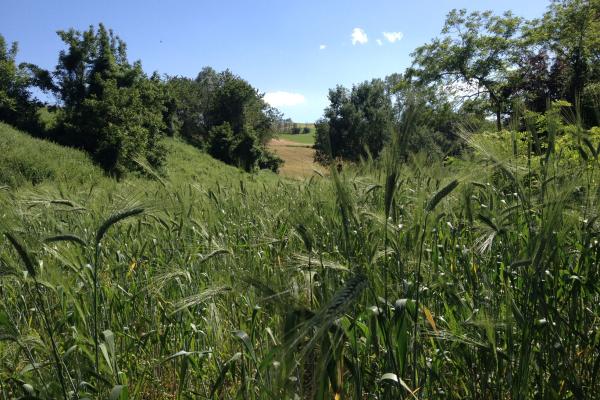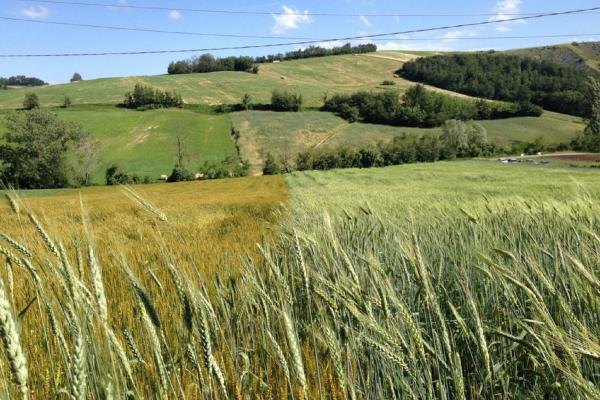Competitiveness increase of high hill and mountain farms through cereal biodiversity valorization under organic farming

Bio2 will increase the competitiveness of mountain farms through cereal-biodiversity valorization and organic farming, helping farmers benefiting from the existence of a growing demand for organic old varieties by the local first processing industry. Combinations of old genotypes of the Triticum genus will be identified, which, grown in mixes under organic cultivation, are able to give adequate yields and good predisposition to processing. Mixes and pure varieties will be characterized and the nutritional quality and some health effects of bread produced from these materials will be evaluated. The increase of the gross saleable production will be measured and a market analysis will be done.
WP1 will crop mixes of old varieties and ancient species of Triticum under organic farming, in order to obtain farm adapted mixtures.
WP2 will measure proteins and microelements (minerals, B vitamins and phenolic acids) of mixtures and pure varieties. A consumer panel will evaluate the acceptability of breads obtained with these flours. Glycemic responses and post-prandial plasma insulin levels will be measured in healthy subjects.
WP3 will carry out an economic and market analysis to find new selling channels.
Two WPs are dedicated to DISSEMINATION AND TRANSFER OF RESULTS AND IMPLEMENTATION OF THE EIP-AGRI NETWORK and TRAINING for the farmers on participatory crop improvement.
In the mountain and high hill areas, the abandonment of farms due to the gradual loss of competitiveness, is a very frequent phenomenon. This has a major impact on land management and landscape protection. The organic sector is growing steadily as well as the demand for organic agricultural products by the first processing industry. Hill and mountain soils have always been characterized by low-input farming, thus the transition to certified organic production should not imply big changes in the farm management. On the other hand, this would lead to an improvement of gross commercial production. Old varieties and ancient species of the Triticum genus are experiencing a time of rediscovery, characterized by a strong consumer interest. Their cultivation on a growing number of hectares would favor the conservation of agro-biodiversity and broaden the range of choice for cereals available to consumers. Consumers also expect to find organic final products from these varieties.
Therefore, the association of biodiversity and organic farming seems successful, hence the name of the project: Bio2. The mixtures – or evolving populations – of non-genetically uniform old varieties, grown on marginal lands, or subjected to extreme climate, adapt and may therefore ensure stability of both yield and quality. Over time, these mixtures will shape according to soil characteristics, microclimate and agronomic techniques (organic farming) becoming a different mix for each farmer. This will encourage the increase of biodiversity and the production of uneven and “biodiverse” food.
Action 1 will test and cultivate under organic farming mixes of old Triticum varieties and ancient species at the farms participating to the Operational Group (OG), in order to obtain distinctive mixes for each farm, and to allow farmers to self-reproduce the seed. The mixes will be compared with pure lines originating them and with modern varieties.
Planned activities:
1) Implementation of experimental fields (small plots) in two mountain areas (two farms) in two growing seasons for agronomic observations. Varieties under study are: old varieties of bread wheat, old varieties of durum wheat, a variety of einkorn, a variety of emmer, a variety of spelt, a mix of old soft wheat constituted in this project and called bread-bio2, a mix of old durum wheat constituted in this project and called durum-bio2, soft wheat mixes today cultivated on small areas, modern durum and bread wheats for comparison.
2) Cultivation in large plots for different formulations of old bread wheat mixes and durum wheat mixes, in two growing seasons in all partner farms. Agronomic observations will be done during the cycle and grains will be analyzed.
3) Management of seeds and farm-scale on farm seed production.
Action 2 aims to characterize the grains of mixes and single varieties under experimentation.
Planned activities:
1) Safety assessment through mycotoxin analysis. Analysis of proteins, dietary fiber, trace elements such as Fe, Zn, Mg and B vitamins (B1, B6, B9) and phenolic acids. Evaluation of the asparagine content for the possible development of acrylamide in the finished product.
The characterization will be performed on whole grain flours (after husking when needed).
2) Determination of the technological quality by rheological analysis and baking trials.
3) Preparation of bread products using the most interesting mixes in terms of agronomic performance and quality. Breads will be made with sourdough or yeast. The bread products obtained will be analyzed to determine: total fat content, protein content, fiber and starch content, fatty acid profile. In addition, content of Fe, Zn, Mg, and B vitamins will bemeasured as well as phenolic compounds. In vitro bioavailability of micronutrients and phenolic compounds will be evaluated. Finally, the in vivo glycemic response and postprandial plasma insulin will be measured for 15 healthy subjects.
Action 3 aims at giving farms concrete assessments of the competitive potential of the crop choices proposed by the project, and practical information on market access policies that allow for the full development of the new production course adopted.
Planned activities:
1) Economic analysis, based both on internal assessments and on market analysis, aimed at determining the potential market share that can be reached, potential volumes, the possible price positioning and therefore, compared with the cost structure, potential profits.
2) Market analysis (examples, success stories, Italian and foreign benchmarks), desk and field, aimed at identifying a list of possible alternative channels of commercialization.
3) Assessment of the economic performance of pilot tests declined from production to alternative marketing methods.
4) From the analyses carried out in points 1), 2) and 3), and in close cooperation with the participating farmers that will provide direct information, as well as through the analysis of the multi-year trend of market prices, measurements will be made of the increase of gross saleable production (PLV) obtained with the crops tested in the project, compared to similar conventional products. All converges in the creation of a model that allows to evaluate alternative scenarios for climate conditions and market prices.
So that we can achieve the greatest impact on target-sectors, it is important to carried out an effective dissemination of objectives and results. The aim of this action is therefore to disseminate research results among farmers and potential stakeholders that could benefit from the experience and know-how accumulated in the two years of experimentation.
A website is online www.bioalquadrato.it
The following tools will also be activated:
- Publication of articles (peer-review and technical papers)
- Video (10 'and 3' long depending on the promotion channel chosen), underlining the importance of biodiversity conservation, organic cultivation and mountain areas.
- Organization of the experimental fields’ visits at all partner farms.
- Final technical meeting inviting researchers and stakeholders.
- Interaction with EU funded projects and regional and national projects related to similar issues.
- Dissemination of project activities in local producers’ markets.
- Participation to conferences with presentation of the results.
A training activity to the farmers participating to the OG has been planned. The activity was approved by Measure 1.1.01 of the Rural Development Program of Emilia Romagna (IT) inthe form of a 27 hours coaching per each farm, divided into two modules.
Module 1 (12 hours)
Identification of weaknesses and potential in terms of production value. Identification of agronomic problems in the management of mixes, old varieties and ancient species and on farm seed production.
Module 2 (15 hours)
Based on the analysis made in the first module, an ad hoc search of possible solutions will be made and solutions will be offered to solve business and practical problems, so as to bring farms to improve their economic performance and competitiveness.
| Titolo/Descrizione | Url | Tipologia |
|---|---|---|
|
Sito web del progetto
|
Sito web
|
|
|
Azienda Stuard
|
Link ad altri siti che ospitano informazioni del progetto
|
|
|
Open Fields (coordinator)
|
Altro
|
|
|
Elena di Cunial (partner)
|
Link ad altri siti che ospitano informazioni del progetto
|
|
|
Facebook page of Open Fields
|
Link ad altri siti che ospitano informazioni del progetto
|
|
|
Molino Grassi (Partner)
|
Link ad altri siti che ospitano informazioni del progetto
|
|
|
University of Parma SAF Dept.
|
Link ad altri siti che ospitano informazioni del progetto
|
|
|
Bio2 at the ICWL18 congress (video)
|
Materiali utili
|
|
|
Experimental fields (video)
|
Materiali utili
|
|
|
Experimental fields (video)
|
Materiali utili
|
|
|
Experimental fields (Video)
|
Materiali utili
|
|
|
Experimental fields (video)
|
Materiali utili
|
|
|
Other dissemination material available at (articoli)
|
Materiali utili
|
|
|
Project full official video (15')
|
Materiali utili
|
|
|
Project official trailer (2' - English)
|
Materiali utili
|
|
|
Project official trailer (2' - Italian)
|
Materiali utili
|
|
|
Articolo sulla Rivista Agronotizie
|
Materiali utili
|
|
|
Articolo sulla rivistaEcoscienza
|
Materiali utili
|

BIO2: coltivare la biodiversità
Il progetto ha portato ad individuare le combinazioni di genotipi antichi appartenenti al genere Triticum, che seminati contemporaneamente nello stesso appezzamento, e quindi…
